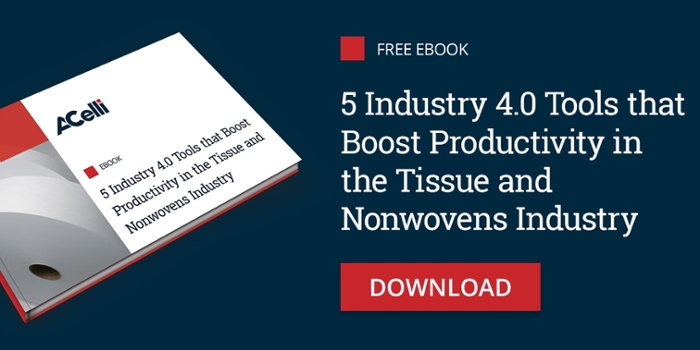[UPDATED ON MARCH 2022]
Predictive maintenance is one of the best things to come out of the Industry 4.0 revolution. It allows companies in the tissue and nonwovens industry to take a proactive approach to machine maintenance, rather than a reactive approach.
Simply put, this means that they can detect a potential mechanical problem and deal with it before the failure of the machine can lead to a disruption to the production line.
This is critical considering it is estimated that unplanned machine downtime costs $50 billion a year and that 42% of unplanned downtime is due to equipment failure.
What Predictive Maintenance Is and How It Works
Essentially, predictive maintenance is a method the help determine the current status of the equipment in order to estimate the timing of maintenance works. Using Industry 4.0 technology we can collect and analyze data coming from each machine on the production line to detect anomalous patterns, so that workers in a tissue and nonwovens plant can see when and where maintenance will be required before any major issues appear.
This is possible because every machine is equipped with sensors capable of relaying operational data in real-time over the cloud to an integrative platform, such as A.Celli Digital Solutions, where the aforementioned data are analyzed by a machine learning application.
Read more: How Deep Learning Can Help You Recognize Tissue and Nonwovens Machine Defects
The machine learning software performs this analysis by using, as baseline machine data:
- Overall Equipment Effectiveness (OEE) standards;
- industry standards;
- your own operational standards;
- historical machine data that identify what metrics will be used as a reference to indicate an issue.
1. Minimized unplanned downtime
The first and perhaps most obvious advantage of predictive maintenance is the ability to minimize unplanned downtime. According to McKinsey, the use of predictive maintenance can reduce machine downtime by 30% to 50%. The reason for this is straightforward. Prior to advanced computer technology, it was difficult to see the wear status of the machine and determine when to take it offline for maintenance before its failure. This was because workers could only visually inspect the machinery, but this, considering also the danger of getting too close, was obviously not enough to detect small changes in machine performance.
Fast-forward to today and technologies makes it possible to observe every aspect of every machine part in real-time during its operation. This means that machine performance is constantly monitored and machine learning is able to analyze the data coming from every machine to detect unwanted changes in operation. This allows plant workers to schedule predictive maintenance, taking the machine offline in a planned way in order to minimize the impact to plant operations.
2. Optimized Planned Downtime
The second, perhaps less obvious advantage of predictive maintenance is the optimization of planned downtime. This is used for processes like the oiling, the cleaning of the machinery and the replacement of parts that wear out frequently. Predictive maintenance makes it possible to schedule this downtime when overall production will experience less of an impact, such as during times when there is less volume on the production line.
Read more: 4 Tools for Tissue and Nonwovens Machines to Reduce and Optimize Idle Times
3. Machinery Life Extension
Finally, predictive maintenance can help significantly extend the useful life of the machinery. Again, McKinsey reports that predictive maintenance extends machine life as much as 20% to 40%. When worn parts are replaced promptly and machines are cleaned, oiled, and cared for regularly, they will last longer. In addition, predictive maintenance will ensure that the maintenance schedule will be adjusted to the equipment obsolescence. Ultimately, the point at which a machine costs the company more than it is worth will be identified so that the company can proceed to its replacement.
Read more: How to measure tissue and nonwovens mill machinery performance with real time analytics
The critical role of predictive maintenance in the tissue and nonwovens industry
As we have seen, predictive maintenance is critical for the survival of any tissue and nonwovens company in today’s competitive global environment. When predictive maintenance is adopted to its fullest capacity it improves workers productivity, because they will be able to promptly identify a problem with a particular machine and effect the necessary repairs before its breakdown. Ultimately, all of this results in optimized machine operations and better profit levels, thanks to reduced maintenance costs, less waste, and lower energy costs.
For more information about predictive maintenance and how to improve the productivity on your tissue and nonwovens production line, please take a look at our eBook “5 Industry 4.0 Tools that Boost Productivity in the Tissue Paper and Nonwovens Industry”!

